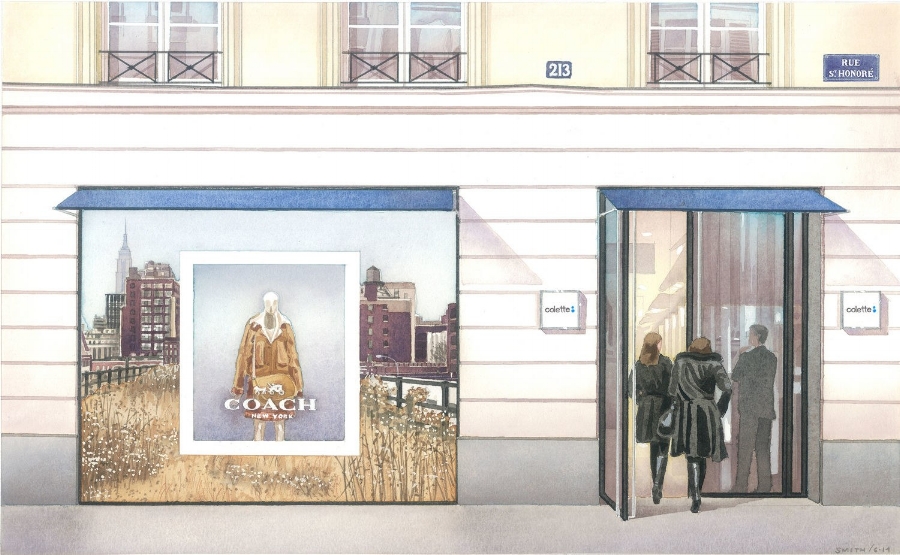
image: Glamour
As the fashion world mourns the impending loss of Colette – what New York Times recently referred to as “the pacesetting Parisian concept store that started numerous designers’ careers and helped change the face of retail” – a few key themes have arisen. There are the creatives who always felt excited, honored to stock there – “All these years later, I feel that it’s such an incredible thing to have Colette as a stockist of Sies Marjan,” says Sander Lak of Sies Marjan.
“I was obsessed by having any magazine I worked on being sold there,” Stefano Tonchi, the editor of W magazine recalls.
Creatives also felt supported, even – or maybe especially – some of the younger ones, which certainly have had a harder time landing stockists in the overly-business-minded U.S. “Our recent project with Colette was met with a level of enthusiasm and support that is rarely found,” young(ish) New York-vased brand Creatures of the Wind’s co-creative director Chris Peters told the Times.
It transcended its most immediate subject – “It represents much more than just fashion; it’s the intersection of music, pop culture and art,” says Peters – and space. “Colette was the first store I knew of in another country,” per Matt Williams, creative director of Alyx. It “mixed historical high fashion with unknown avant-garde designers, streetwear and technology.”
Colette’s collaborations – always “new” and “cool,” per Marc Newsom – have seen it teaming with brands ranging from Raf Simons to the Gap, Hermès and Aston Martin, and most recently, Balenciaga.
“They have things no one else has,” Karl Lagerfeld said last year. Lauren Santo Domingo calls the store’s stocks “unexpected,” and says that “somehow it just worked.” She further noted the merchandizing; Daphne Guinness recalls that “the way it was curated had soul.” The store brought “an energy of cool to fashion,” according to Elbaz.
And, of course, it was always a family business. “Most of all, I respect the way in which Colette remained a family business all its life. Mother and daughter working side by side,” says Williams. “The one thing that always impressed me was … you would always see Colette [Roussaux] and Sarah [Andelman] arranging the windows together. At the end of the day, it was that very human touch that brought life to the store,” echoes Alber Elbaz.
The duo’s hands-on approach dominated the environment. “Sarah’s sophistication and faith also made it remarkably approachable,” says Newsom. “They have or had something for everyone,” per Guinness.

The Question Is: Now What?
The question is: What – if anything – will be able to fill the looming void that comes as of December when Colette closes its doors? The first (and maybe only) contender that has been raised is Rei Kawakubo’s Dover Street Market – the two do have some similarities, after all.
They both take risks and aim to provide a different experience for consumers, especially when it comes to stocking collaborations and pioneering young design talent, and they have been rewarded for it. “Being stocked at DSM has become a badge of honor,” wrote the Telegraph’s fashion director Lisa Armstrong last year.
Both work to support young brands. According to Kawakubo’s husband and her closest DSM partner, “We want to be a store that can directly and indirectly give courage to young designers and luxury brands alike to pursue the path of creation and freedom, and encourage individual anti-corporate expression.”
DSM certainly appears to boast the following. “Shopping there is a sign of refined and eclectic taste, Armstrong says, and to be frank, “it really is a wonderful place to shop.” And it is arguably ripe to open a Parisian outpost, where it currently lacks a brick-and-mortar presence.
But one thing stands out as a potential issue or maybe even a strength, depending on how you look at it: Andelman says she “chose everything for Colette by myself.” It was “not like a department store where there’s a team of 15 people analyzing footwear sales on big charts.”
While “Rei is very involved in DSM, most particularly from the visual and design point of view, as well as the overall concept,” all major decisions “such as who to invite, who and what to buy, are made by me, with my teams,” says Adrien Joffe, who moonlights as the president and CEO of Comme des Garcons. This is a seemingly a bit at odds with the Colette model.
In this way, DSM – which is overseen by Joffe – is probably more calculated; the scale likely tips towards commerce over art – even if it is slight. It was, however, under Joffe’s watch that CDG spawned the brand’s various apparel and accessories offshoots, like the t-shirt concept “Play” and its wallet line, which have proven essential in enhancing its commercial appeal (read: making serious money).
Therefore, DSM may be a bit more corporate (or as corporate as an anti-corporate establishment could be) than wildly uncalculated and creative. In today’s business world, however, that is not necessarily a bad thing. (Do not tell me that a moment that the thought of financial difficulties for Colette did not cross your mind. Why else close down an otherwise thriving brand when it could be sold, licensed, etc.?)
As for whether meeting the hard numbers required to keep a store, or network of stores, open in the current retail climate gives rise to the magic that was produced for 20 years by Colette, is another matter entirely. As of now, it seems like a bit of a stretch.







